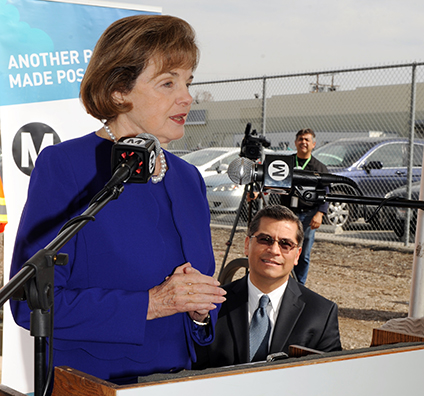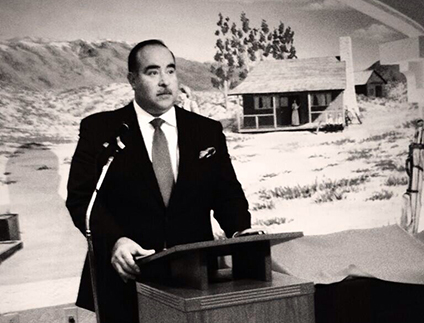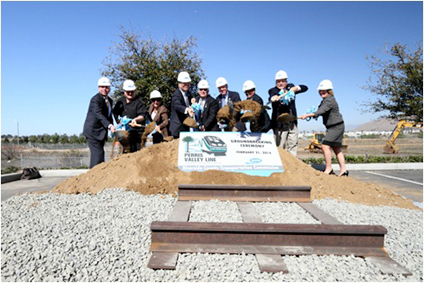Join these firms in sponsoring Mobility 21’s 2014 Southern California Transportation Summit. Click here to view a larger graphic.
Mobility 21 Summit Sponsorships
Open Monday to General Public
Sponsorships for the 13th annual Southern California Transportation Summit open on Monday to the general public! Join us for California’s largest one-day transportation event on Friday, Sept. 5 at the Disneyland Hotel in Anaheim.
2014 Summit sponsors will experience:
- Access to public and private sector transportation decision-makers
- Visibility at California’s largest one-day transportation Summit and Expo
- Pre-event publicity to thousands of transportation sector professionals
- Networking with business partners, clients, elected leaders and speakers
- Value for your investment with highly competitive sponsorship rates
Don’t let your business miss out on this sponsorship opportunity! Click here to view the sponsorship packages. E-mail Marnie O’Brien Primmer for more details or call 949.288.6884.
Mobility 21 Open Position:
Executive Director
Mobility 21 is a seven-county coalition bringing together business leaders and transportation providers to advocate for increased funding for transportation infrastructure investment. A 501c(6) nonprofit, Mobility 21 is seeking an individual to fill the position of Executive Director. The successful candidate will have an in-depth knowledge of transportation policy, as well as a background in managing complex conference-type events and a track record of successful fundraising.
For more information and to apply for the position, contact Paul Granillo, President and CEO of the Inland Empire Economic Partnership and Chair of Mobility 21.
Assemblymember Bonnie Lowenthal
Talks Transportation Committee’s Top Priorities
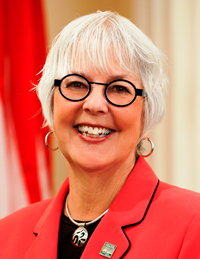 This month we turn our attention to Assemblymember Bonnie Lowenthal, Chair of the Assembly Transportation Committee, as she shares the committee’s priorities for the year, next steps for cap-and-trade and keeping the transportation system from falling off the “fiscal cliff.”
This month we turn our attention to Assemblymember Bonnie Lowenthal, Chair of the Assembly Transportation Committee, as she shares the committee’s priorities for the year, next steps for cap-and-trade and keeping the transportation system from falling off the “fiscal cliff.”
M21: What are the priorities of the Assembly Transportation Committee this year?
AL: It is already shaping up to be a very busy year for the committee and a number of important issues are arising:
1. “Modernizing” Caltrans. On Monday, March 3, 2014, we’ll convene an informational hearing on the subject of the department, what it does well, and what needs some work.
The recently released report issued by State Smart Transportation Initiative (SSTI) gives us a great starting point. SSTI was commissioned by the California State Transportation Agency (CalSTA) to assess Caltrans’ performance and to make recommendations for improvements. The report is the conclusion of a year’s effort working with dozens of stakeholders to examine the current status of the state’s transportation systems and to explore a new vision for those systems.
In short, the SSTI report finds that Caltrans is “significantly out of step” with best practices in the transportation field and with many of the state’s policy expectations. The report further suggests that this appears to be, at least in part, the result of:
- An unclear mission and vision for the department;
- Resources and skills being out of alignment with policy goals; and
- Antiquated management practices.
The SSTI report charts a short-term course for making some initial, much-needed changes within Caltrans. The report also makes a strong case that the Legislature needs to work with Administration to better align policy goals with resources. We’ll be working toward that end this year.
2. Department of Motor Vehicles’ implementation of AB 60 (Alejo). The DMV is hard at work implementing AB 60 to provide driver’s licenses for persons who are unable to submit satisfactory proof that they have a legal presence in the United States. This was an extremely important bill to the committee and we will continue working with DMV to ensure program is ready to come online by January 1, 2015.
3. Cap-and-trade revenue. The Governor’s budget proposes significant cap-and-trade revenue expenditures for transportation:
- $250 million to the High-Speed Rail Authority high-speed rail;
- $50 million to Caltrans for infrastructure investments in conventional passenger rail and local mass transit systems that maximize integration with high-speed rail and that increase rail and transit trips;
- $100 million to the Strategic Growth Council for a sustainable communities implementation program and for support to other areas with greenhouse gas reduction policies that are not subject to SB 375 requirements; and, finally
- $200 million to the Air Resources Board to accelerate the transition to low carbon freight and passenger transportation.
Although the budget allocations are not within the purview of my committee, naturally we will be keeping a keen eye on budget deliberations because of their major policy implications.
4. High-Speed Rail. We have to figure our way through the pending litigation. Perhaps the Appeals Court will provide some guidance. In the meantime, we have to ensure work being done by the High-Speed Rail Authority is productive and results in meaningful investments.
5. Funding. This is probably the number one priority on all our lists. We are near a funding calamity in transportation. As motor vehicle fuel standards rise, revenue from the excise tax drops. By 2030, fuel standards will be such that cars will need literally half as much fuel as the use today to drive the same distance. That’s great news for consumers and our environment, but it’s a looming crisis for our transportation funding. In simple terms, this means our already-limited funding will be quite literally cut in half. There is no way we can sustain our existing systems in the wake of these cuts. Tomorrow’s transportation funding woes will be exponentially greater than they are today absent some sort of near-term funding relief.
M21: Last year you authored AB 574 to guide the investment of cap-and-trade revenue for regional projects and programs. How do you plan to advance this legislation in 2014?
AL: Unfortunately, AB 574 was held in the Assembly Appropriations Committee in 2013 and I will not be directly pursuing cap-and-trade investment legislation this year. Rather, I will be working with our budget committees to ensure cap-and-trade allocations meet many of the features we sought in AB 574, such as clear performance metrics, competitive programs, and eligibility criteria that allow a combination of project elements so we can maximize emission reductions.
In addition, I look forward to supporting legislation that emphasizes new funding strategies for transit, affordable housing and walkable communities. The tools we see in SB 1 (Steinberg) and the Governor’s budget proposal for infrastructure financing districts show some great promise that could help communities across the state.
M21: With Proposition 1B now at an end and looming depletion of the Highway Trust Fund, what are your plans to ensure that California’s transportation system does not fall off the “fiscal cliff”?
AL: I believe our first order of business is to work with the Administration to get its house in order. We will not be successful going to the voters with a request for more funding for transportation if we cannot assure them that their money will be spent wisely. We have to restore that trust. As a start, my committee will convene an informational hearing next month to look at how to improve Caltrans. Concurrently, we will be leaning on the California State Transportation Agency to provide us viable funding alternatives to consider. And, finally, we’ll be looking at existing programs to eliminate policies and procedures that work at cross-purposes—all toward a goal of restoring the public’s faith and trust.
M21: What do you believe is the future of public-private partnerships in California, with P3 authority for transportation expiring soon?
AL: Existing law gives us until January 1, 2017, so we may not see this issue resolved this year. Regardless, I believe it is in all our interests to encourage a healthy P3 climate in California, so long as we can strike the appropriate balance that encourages private capital investment yet ensures the public’s interests are adequately protected.
Mobility 21 to Co-Host Reception
Honoring California Transportation Commission
Join Mobility 21, together with the Orange County Transportation Authority, WTS Orange County, the Orange County Business Council and OC Moves, at a reception honoring the California Transportation Commission. The reception is Thursday, March 20 from 5:30-7 p.m. at the DoubleTree by Hilton in Santa Ana, Orange County. Don’t miss this opportunity to network with transportation and business leaders from throughout California! Click here to register.
Sponsorships available
$500: Includes logo on event marketing
$250 (small businesses and nonprofits only): Includes company name on event marketing
Contact Jenny Larios to sponsor at Jenny.Larios@hdrinc.com or 714.336.5493.
Senator Dianne Feinstein joins other federal officials, as well as Metro, state and local elected leaders, to announce the receipt of a Full Funding Grant Agreement from the Federal Transit Administration for the Regional Connector Project. Click here to watch a video from the event.
Federal Government Approves $670 Million Grant
And $160 Million Loan for Regional Connector
From The Source
Officials from Metro and the Federal Transit Administration signed a pair of agreements last week that will provide a $670-million federal grant and a $160-million federally-backed loan for the Regional Connector light rail project. The total budget of the project is $1.37 billion.
In practical terms, the agreements clear the way for construction to begin later this year on the 1.9-mile underground light rail line in downtown L.A. that will tie together the existing Blue Line, Expo Line and Gold Line with tracks between 7th/Metro Center and Little Tokyo. When the project is complete — forecast for 2020 — passengers on those lines will be able to travel through downtown without having to transfer to another line.
The project will also allow trains to run more frequently through downtown. Blue Line and Expo Line trains currently must turn around at 7th/Metro Center, a time-munching maneuver.
Utility relocations on the project are already underway with construction expected to begin later this year after the Metro Board of Directors selects a contractor to build the line. Metro already has three light rail projects currently under construction — the Crenshaw/LAX Line, the Expo Line and the Gold Line Foothill Extension. The first phase of the Purple Line Extension of the subway is also expected to sign funding agreements with the federal government later this year, allowing the Metro Board to select a contractor to build that project.
That means that within the next calendar year, Metro could have an unprecedented five rail projects being built simultaneously that will add about 29 miles of rail to the existing 87-mile Metro Rail network. All five projects are also receiving significant funding from Measure R, the half-cent sales tax increase approved by 68 percent of Los Angeles County voters in 2008.
The Connector is the first Metro project to receive a federal New Starts grant since the Eastside Gold Line, which opened in 2009. New Starts is a federal program designed to help local transit agencies build expensive transit projects.
The loan is coming from the federal TIFIA program, which helps local areas secure low-interest loans that are cheaper than loans found on the open market. The TIFIA program is part of Metro’s America Fast Forward initiative that was expanded in the most recent federal multi-year transportation bill. Metro is seeking to have the program renewed and expended in the next bill, which Congress is expected to debate this year.
The Connector was originally envisioned as a rail project that would run at street level through downtown. Public opinion, however, swayed Metro to put the line underground, which increased costs but will also provide faster travel speeds and eliminate the need for a rail undercrossing at Alameda Street. The increased cost is the reason that federal funding is crucial for the project.
Paul Granillo, President and CEO of the Inland Empire Economic Partnership, and Chair of Mobility 21, as he prepares to emcee the 2014 Inaugural “Turning Red Tape to Red Carpet” Awards Reception.
IEEP Honors Public Sector
Leaders at Inaugural Event
On Feb. 19, the Inland Empire Economic Partnership (IEEP) held its Inaugural 2014 “Turning Red Tape to Red Carpet” Awards Reception, with the purpose of recognizing and awarding the public sectors that work with businesses to promote job creation and support business growth in the region. The goal of “Red Tape to Red Carpet” is to honor those public sector agencies that are doing good work and encourage them to share these best practices. The lively reception was well-attended, with over 100 people representing both the public and the business sectors in the Inland Empire. IEEP will continue to recognize public entities on an annual basis.
Visit IEEP’s website for a list of the honorees.
Officials celebrate the start of construction on Riverside County’s Metrolink Perris Vally Line.
RCTC Breaks Ground on
Perris Valley Metrolink Extension
On Feb. 21, the Riverside County Transportation Commission (RCTC) joined federal, state and local officials, along with a number of business leaders, to mark the beginning of construction of the 24-mile-long Perris Valley Metrolink Extension.
The $248.3 million project will extend the current Metrolink 91 Line to new stations in North Riverside, Moreno Valley/March Field, Downtown Perris and South Perris/Menifee. In addition, the project will construct and rehabilitate railroad tracks and upgrade 18 at-grade crossings. The event marks the first significant service expansion of Metrolink’s six-county commuter rail system in more than a decade, and the first expansion of the Metrolink system in terms of added mileage since 1994.
One major theme during the groundbreaking ceremony was the link between effective public transportation and job creation. The event was held near the new office of the UC Path Center near March Air Base. UC Path recently relocated to Riverside and will employ as many as 480 people involved in administrative responsibilities for the University of California. RCTC officials hope that more employers will follow that trend once additional train service is completed.
“Riverside County is an excellent location for employers and businesses,” said RCTC Chair Marion Ashley. “The addition of train service by the end of next year will make it an even more attractive job center.”
In addition to the economic benefits, Congressman Mark Takano (D-Riverside) praised the project for its positive impact on mobility.
“With this brand new Metrolink line, Riverside County commuters will finally be one step closer to traffic relief, as the Perris Valley Line will take an estimated 4,000 cars off the road each day,” said Takano. “Investing in local infrastructure projects is one of the best stimulants for our economy, as they create jobs, increase efficiency, and provide resources for generations to come.”
The actual construction project is projected to create as many as 4,000 jobs during the two-year duration of the work. Rail service is expected to open to riders by late 2015. Funding sources for the project include Riverside County’s voter-approved Measure A program, a $75 million Federal Transit Administration grant and additional funding from the State of California. When finished, the project will improve mobility, enhance safety at rail crossings, reduce noise, create new jobs and offer an environmentally-friendly alternative to driving alone.
For more information on the project, please see http://perrisvalleyline.info.
OCBC Soars to New Heights at Annual Dinner
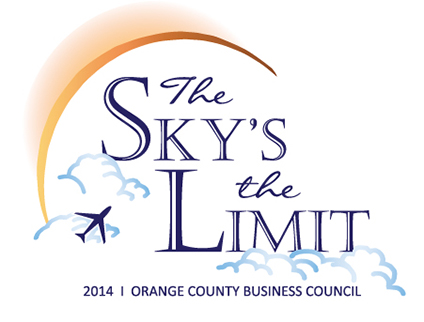 More than 700 of Orange County’s business leaders gathered last Thursday evening at Hotel Irvine for Orange County Business Council’s (OCBC) 2014 Annual Dinner, “The Sky’s the Limit,” sponsored by FivePoint Communities. The event featured the installation of the OCBC Board of Directors and 2014 Chair, Les Card of LSA Associates Inc., who succeeded outgoing Chair Michael Hornak of Rutan & Tucker LLP. The evening was a celebration of Orange County’s economy bounding toward not only recovery, but soaring progress and success. The theme “The Sky’s the Limit” encourages business leaders to take advantage of the unlimited growth, unlimited opportunity, and unlimited potential in Orange County and continuing its position as a global economic leader.
More than 700 of Orange County’s business leaders gathered last Thursday evening at Hotel Irvine for Orange County Business Council’s (OCBC) 2014 Annual Dinner, “The Sky’s the Limit,” sponsored by FivePoint Communities. The event featured the installation of the OCBC Board of Directors and 2014 Chair, Les Card of LSA Associates Inc., who succeeded outgoing Chair Michael Hornak of Rutan & Tucker LLP. The evening was a celebration of Orange County’s economy bounding toward not only recovery, but soaring progress and success. The theme “The Sky’s the Limit” encourages business leaders to take advantage of the unlimited growth, unlimited opportunity, and unlimited potential in Orange County and continuing its position as a global economic leader.
The night concluded with keynote speaker George F. Will, columnist, author and Pulitzer Prize winner, who spoke about many controversial issues making today’s news headlines, such as social security, health care and wealth inequality. Will shared insights regarding the opportunities and challenges facing today’s economy and focused on the importance of every citizen becoming aware and involved in congressional decisions. Will, a well-known baseball aficionado, often lightened the mood of the room with comments on his beloved team, the Chicago Cubs – joking at one point that they were merely in a “106-year recovery” since their last World Series win. He also applauded dinner attendee and Angels Baseball owner, Arte Moreno, for his leadership and team management. Angels Baseball sponsored the VIP Reception after Will’s keynote address, where other dinner sponsors and OCBC Board Members met Will and toasted to a promising 2014 in Orange County.
Metrolink and sbX vehicles were on hand at the Downtown San Bernardino Passenger Rail Project (DSBPRP) and the San Bernardino Transit Center (SBTC) groundbreaking event, symbolizing the intermodal connectivity coming to the region.
Multi-Modal Options Celebrated as SANBAG
Starts Construction on Two Major Transit Projects
On Feb. 26, hundreds of residents, business owners and other community members gathered in the heart of San Bernardino to join San Bernardino Associated Governments (SANBAG), Omnitrans, Metrolink, the Federal Transit Administration, the California Transportation Commission, the County of San Bernardino and the City of San Bernardino as they celebrated the start of construction for the Downtown San Bernardino Passenger Rail Project (DSBPRP) and the San Bernardino Transit Center (SBTC).
Mayor Patrick Morris welcomed the crowd by stating, “This marks the culmination of many years of work to bring these transformative projects to construction. These two projects are examples of how creating intermodal connections between commuter rail, bus rapid transit, and local and regional bus service can provide enhanced benefits to current transit uses and make these travel modes more attractive to future riders in the region.”
The approximately $25 million SBTC will serve as a key multi-modal transportation hub linking a variety of transportation options that include sbX (bus rapid transit), 13 local bus routes, other regional transit providers, Metrolink and the future passenger rail to Redlands. The SBTC itself will feature a 22-bay bus transit center and an enclosed lobby with public restrooms and customer service areas.
The DSBPRP project will cost nearly $103 million dollars and extend Metrolink service one-mile to the east to connect to downtown San Bernardino at the SBTC. The project will improve access to other modes of transportation, make modifications near the historic Santa Fe Depot that include a pedestrian overpass for safe access to boarding, and enhance street crossings for safer, more efficient movement of the trains.
Together, these two projects expand SANBAG’s commitment to providing transportation options for the people of San Bernardino County. For more information about this project, visit them on the web at www.sanbag.ca.gov.
Don’t Miss These Upcoming Events!

Mileage-Based User Fee Alliance National Conference
Thursday, March 12
Washington, D.C.
More info | Register
As gas tax revenues dwindle, policymakers in the U.S. have had to divert billions from the general fund to pay for infrastructure. This is increasing pressure on transportation policy makers to search for new, viable road financing mechanisms. The conference will focus on why mileage-based fees are a viable option and how they are working now.
Transportation Events in the Community
March 9-11
APTA: Annual Legislative Conference
More info | Register
March 10-12
LA Area Chamber: Access D.C.
More info | Register
Tuesday, March 11
California Transportation Congressional Reception
More info | Register
Wednesday, March 12
Mileage Based User Fee Alliance: National Conference
More info | Register
Monday, March 17
WTS-LA: Fixing Ground Transportation: A Rail Active Approach for Mobility in L.A.
More info | Register
Thursday, March 20
Reception Honoring CTC in Orange County
More info | Register
Thursday, April 17
IEEP: Annual State of the Region Conference
More info | Register
Friday, May 2
LA Area Chamber: 88th Annual World Trade Week Kickoff Breakfast
More info | Register
May 5-8
Alternative Clean Transportation (ACT) Expo
More info | Register
May 19-21
OCBC: Advocacy Trip to Washington, D.C.
More info | Register
Thursday, May 22
CTF: Annual Awards Luncheon
More info | Register | Nominations due March 3
Thursday, May 29
ACC-OC: Infrastructure Summit
More info | Register
Thursday, June 12
SANBAG: General Assembly
More info | Sponsor
Friday, Sept. 5
Mobility 21 Summit: Disneyland Hotel, Anaheim
Sponsor



